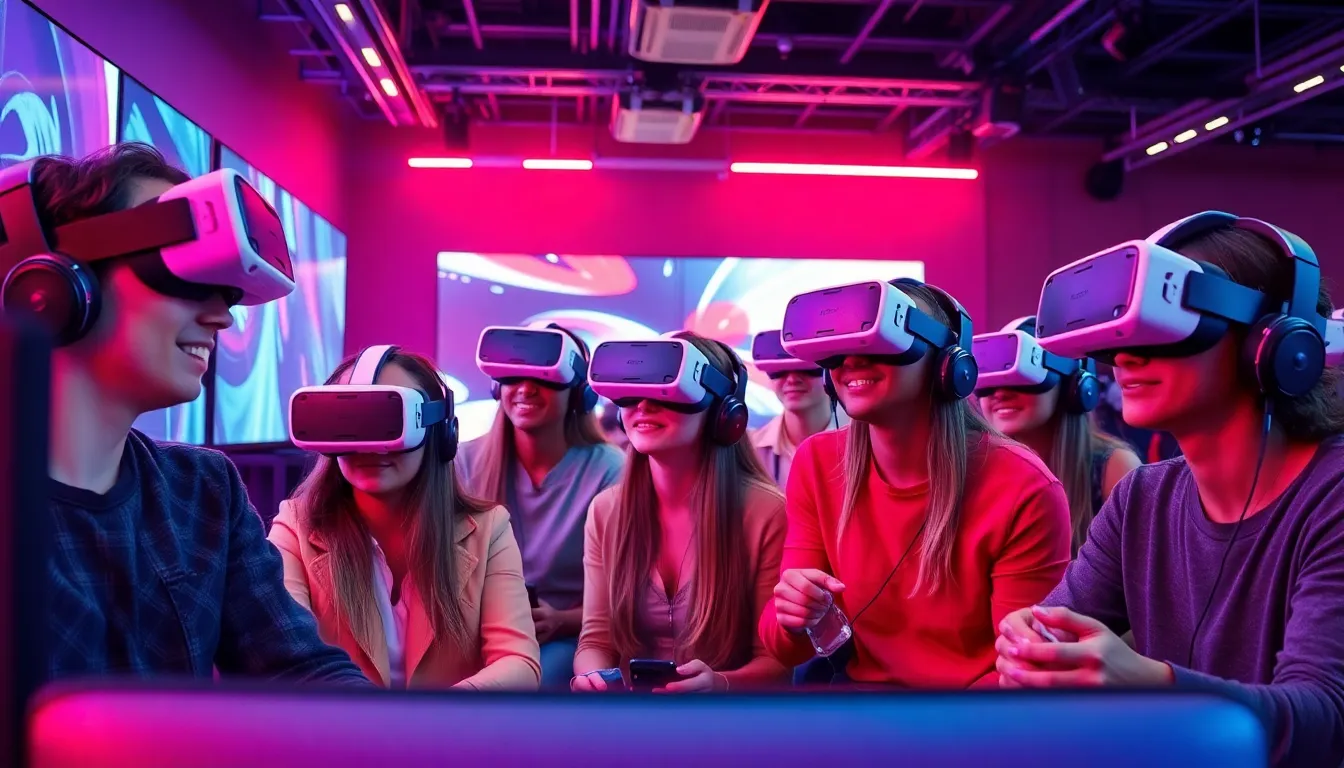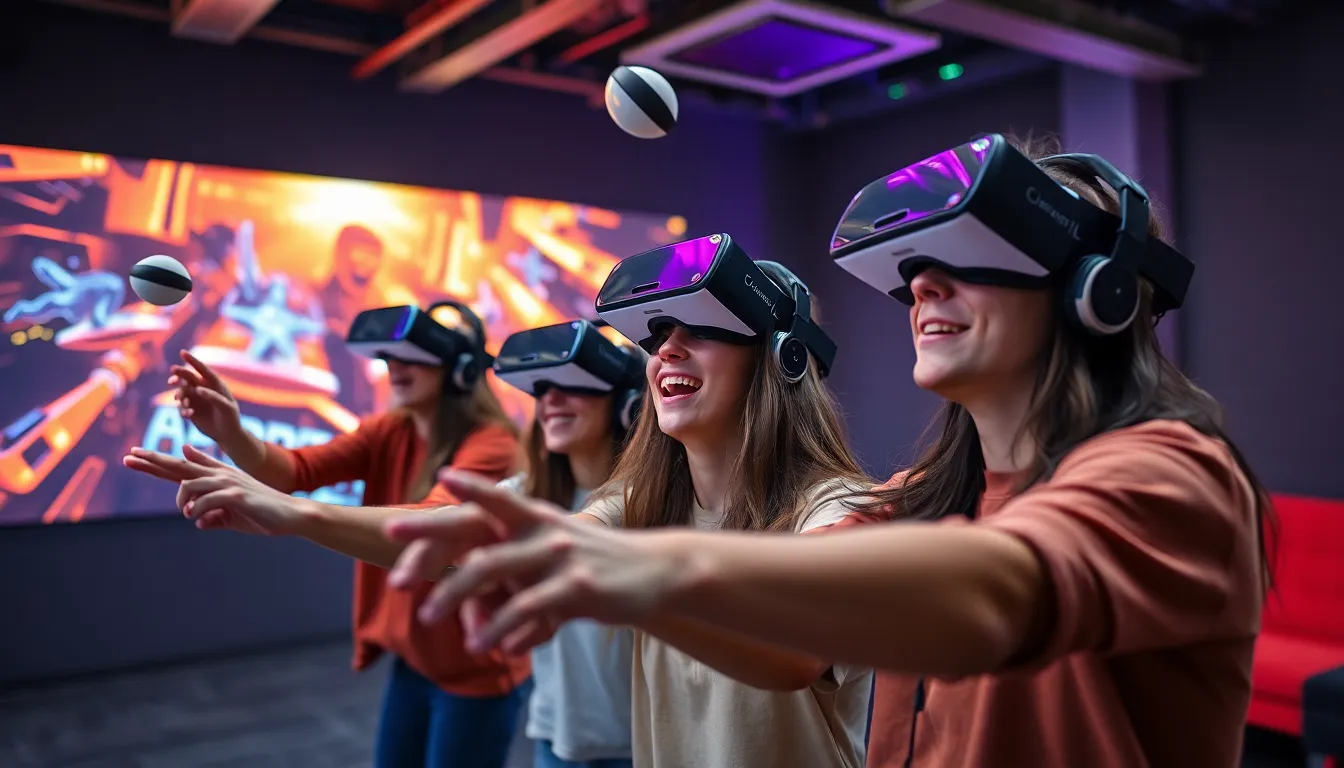Imagine stepping into a world where your wildest gaming dreams become reality. A virtual reality game room isn’t just a space; it’s a portal to adventure, excitement, and maybe a little friendly chaos. Gone are the days of couch potato gaming—now, players can dodge laser beams, battle fierce dragons, or even dance like nobody’s watching, all without leaving the comfort of their living room.
Table of Contents
ToggleOverview of Virtual Reality Game Rooms
Virtual reality game rooms offer users immersive environments designed for exploration and engagement. Players experience lifelike simulations where they can participate in various activities that traditional games cannot replicate. These rooms often utilize advanced hardware, including VR headsets and motion sensors, to enhance realism.
Space configuration plays a crucial role in the functioning of VR game rooms. Many setups include dedicated areas for movement, ensuring that players can navigate without obstacles. For instance, a typical VR room may range from 10 by 10 feet to larger areas where players can move freely.
Popular game genres for VR experiences often include first-person shooters and adventure games. Many users enjoy the excitement of feeling physically present in the game world while battling enemies or exploring vast landscapes. Players can also collaborate with friends in multiplayer modes, creating social experiences that enhance enjoyment.
The technology behind VR game rooms continues to evolve, incorporating features such as haptic feedback and spatial audio. Innovations like these intensify the sensory experience, making actions like shooting arrows or dodging attacks far more engaging. With advances in VR software, developers consistently introduce new titles, keeping the content fresh and engaging.
Safety measures should not be overlooked. Users must be aware of their surroundings, ensuring a safe gaming experience while fully immersed. Guidelines often recommend removing potential hazards and maintaining clear communication with others in the vicinity.
Overall, virtual reality game rooms redefine entertainment by blending technology and gaming, offering vibrant experiences that captivate users. Players embrace these environments, pushing the boundaries of how games are played.
Benefits of Virtual Reality Game Rooms

Virtual reality game rooms offer numerous advantages that enhance the gaming experience. These spaces enable players to fully engage in an interactive world.
Immersive Experience
Immersion stands as one of the primary benefits of virtual reality game rooms. Players feel fully present in their gaming environments, as advanced technologies create lifelike graphics and effects. Detailed worlds allow for exploration without limits, making every game session a unique adventure. Haptic feedback heightens this immersion, transforming how players perceive impacts and movements. Shifting perspectives from traditional screens to a 360-degree view changes gameplay dynamics. Realistic sound also plays a crucial role, as spatial audio provides an accurate sense of direction and depth within the game. Such elements combine to deliver a truly captivating experience.
Social Interaction
Social interaction thrives in virtual reality game rooms. Multiplayer modes allow friends to connect and engage in gaming together, regardless of physical distance. Sharing experiences in these virtual spaces fosters bonds and creates memorable moments. Players can team up for challenges or compete against each other, enhancing the thrill of gameplay. Communication in VR can feel more personal compared to traditional gaming, as avatars mimic real-life behaviors and gestures. This social aspect encourages teamwork and collaboration. Players build communities, share their experiences, and participate in group events, making virtual reality an inclusive platform for gaming enthusiasts.
Key Features to Look For
Several features define a top-notch virtual reality game room. Prioritizing quality equipment and a diverse game selection significantly enhances the overall experience.
Equipment and Hardware
VR headsets are fundamental in providing an immersive experience. Options like the Oculus Quest 2 or HTC Vive Pro deliver high-resolution graphics and comfort for extended use. Motion sensors play a crucial role in tracking movements accurately. Devices such as the Valve Index Controllers offer natural hand tracking for seamless interaction. Haptic feedback systems, including gloves or vests, intensify the physical sensation of gameplay. Ensuring adequate space for movement stands as essential for safety while navigating the virtual environment.
Game Selection
A diverse game selection attracts various gaming interests. Popular genres include adventure, action, and sports games, which cater to different player preferences. Titles like Beat Saber or Half-Life: Alyx showcase the appeal of immersive storytelling and engaging mechanics. Multiplayer options significantly enhance social interaction; games such as VR Chat create opportunities for collaboration and friendly competition. Regular updates and new releases ensure continued excitement and engagement within the game room, keeping players coming back for memorable experiences.
Setting Up Your Virtual Reality Game Room
Creating a virtual reality game room involves thoughtful planning and investment. Prioritizing the right elements ensures an optimal gaming experience.
Space Considerations
Room size plays a crucial role in virtual reality setups. A minimum of 6.5 feet by 6.5 feet typically allows for safe movement. Clear spaces without obstacles enhance mobility and prevent accidents. Additionally, ceilings should be at least 8 feet high to accommodate overhead movements. Proximity to power outlets simplifies cable management and equipment placement. Overall, measuring the space before setup optimizes the gaming environment.
Budgeting and Costs
Costs for establishing a virtual reality game room vary based on equipment choices. Quality VR headsets range from $300 to $1,000, depending on features and capabilities. Further, motion sensors and controllers add another $100 to $300. Setting aside funds for additional accessories, such as haptic feedback devices, improves the experience with costs around $100. Ultimately, budgeting between $800 and $2,000 for a complete setup delivers value and enjoyment for gamers.
Virtual reality game rooms represent a groundbreaking evolution in gaming that captivates players like never before. The immersive environments and cutting-edge technology create experiences that transcend traditional gaming. With the right setup and equipment, players can dive into fantastical worlds while enjoying the social aspects of multiplayer modes.
As technology continues to advance, the potential for even more engaging experiences grows. Investing in a virtual reality game room not only enhances entertainment but also fosters connections among friends and family. Embracing this innovative gaming format allows players to explore new dimensions of fun and adventure, making every gaming session a memorable journey.




